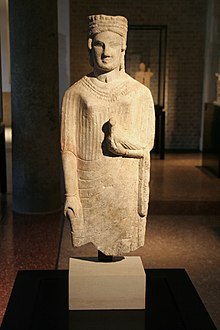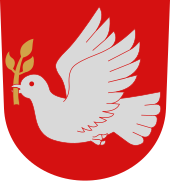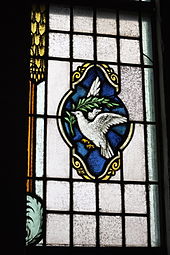Doves as symbols

Doves,typicallydomestic pigeonswhite inplumage,are used in many settings as symbols ofpeace,freedom,orlove.Doves appear in the symbolism ofJudaism,Christianity,Islamandpaganism,and of bothmilitaryandpacifistgroups.
Mythology[edit]

In ancientMesopotamia,doves were prominent animal symbols ofInanna-Ishtar,the Goddess of love,sexuality,andwar.[1][2]Doves are shown on cultic objects associated with Inanna as early as the beginning of the third millennium BC.[1]Lead dove figurines were discovered in the temple of Ishtar at Aššur, dating to the thirteenth century BC,[1]and a painted fresco fromMari, Syriashows a giant dove emerging from a palm tree in the temple of Ishtar,[2]indicating that the goddess herself was sometimes believed to take the form of a dove.[2]
In theancient Levant,doves were used as symbols for theCanaanitemother goddessAsherah.[1][2][3]
Theancient Greekword for "dove" wasperisterá,[1][2]which may be derived from the Semitic phraseperaḥ Ištar,meaning "bird of Ishtar".[1]In classical antiquity, doves were sacred to the Greek goddessAphrodite,[4][5][1][2]who absorbed this association with doves from Inanna-Ishtar.[2]Aphrodite frequently appears with doves inancient Greek pottery.[4]The temple ofAphrodite Pandemoson the southwest slope of theAthenian Acropoliswas decorated with relief sculptures of doves with knottedfilletsin their beaks[4]and votive offerings of small, white, marble doves were discovered in the temple of Aphrodite atDaphni.[4]During Aphrodite's main festival, theAphrodisia,her altars would be purified with the blood of asacrificed dove.[6]Aphrodite's associations with doves influenced the Roman goddessesVenusandFortuna,causing them to become associated with doves as well.[3]
In theJapanese mythology,doves areHachiman'sfamiliar spirit.Hachiman is thesyncretic divinityof archery and war incorporating elements from bothShintoandBuddhism.
Judaism[edit]

According to thebiblicalstory (Genesis8:11), a dove was released byNoahafter theFloodin order to find land; it came back carrying a freshly plucked olive leaf (Hebrew: עלה זיתalay zayit),[7]a sign of life after the Flood and of God's bringing Noah, his family and the animals to land.Rabbinicliterature interpreted the olive leaf as "the young shoots of the Land of Israel"[8]or the dove's preference for bitter food in God's service, rather than sweet food in the service of men.[9][10][11]
TheTalmudcomparesthe spirit of Godhovering over the waters to a dove that hovers over her young.[12][13][14]
In post-biblical Judaism, souls are envisioned as bird-like (Bahir119), a concept that may be derived from the Biblical notion that dead spirits "chirp" (Isa. 29:4). TheGuf,or Treasury of Souls, is sometimes described as acolumbarium,a dove cote. This connects it to a related legend: the "Palace of the Bird's Nest", the dwelling place of the Messiah's soul until his advent (ZoharII: 8a–9a). TheVilna Gaonexplicitly declares that a dove is a symbol of the human soul (Commentary to Jonah, 1). The dove is also a symbol of the people Israel (Song of Songs Rabbah 2:14), an image frequently repeated inMidrash.
Christianity[edit]

The symbolism of the dove in Christianity is first found in the Old Testament Book of Genesis in the story of Noah's Ark, "And the dove came in to him at eventide; and, lo, in her mouth an olive-leaf plucked off: so Noah knew that the waters were abated from off the earth".Genesis 8:11And, also, in the New Testament Gospels of Matthew and Luke, both passages describe after the baptism of Jesus, respectively, as follows, "And Jesus when he was baptized, went up straightway from the water: and lo, the heavens were opened unto him, and he saw the Spirit of God descending as a dove, and coming upon him".Matthew 3:16and, "And the Holy Spirit descended on him in bodily form like a dove. And a voice came from heaven:" You are my Son, whom I love; with you I am well pleased ".Luke 3:22The Holy Spirit descending on Jesus and appearing in the bodily form of a dove is mentioned in the other two Gospels as well (seeMark 1:10andJohn 1:32).

The use of a dove and olive branch as a symbol of peace originated with the early Christians, who portrayed the act ofbaptismaccompanied by a dove holding an olive branch in its beak and also used the image on theirsepulchres.[15][16]
Christians derived the symbol of the dove and olive branch from Greek thought, including its use of the symbol of the olive branch,[17]and the story ofNoahand the Flood. Although Jews never used the dove as a symbol of peace, it acquired that meaning among early Christians, confirmed by StAugustine of Hippoin his bookOn Christian Doctrineand became well established.[18]
In ChristianIconography,a dove also symbolizes theHoly Spirit,in reference toMatthew3:16 andLuke3:22 where the Holy Spirit is compared to a dove at theBaptism of Jesus.[19][20]
The early Christians in Rome incorporated into their funerary art the image of a dove carrying an olive branch, often accompanied by the word "Peace". It seems that they derived this image from the simile in the Gospels, combining it with the symbol of the olive branch, which had been used to represent peace by the Greeks and Romans. The dove and olive branch also appeared in Christian images of Noah's ark. The fourth centuryVulgatetranslated the Hebrewalay zayit(leaf of olive) inGenesis8:11 as Latinramum olivae(branch of olive). By the fifth century,Augustine of Hippowrote inOn Christian Doctrinethat "perpetual peace is indicated by the olive branch (oleae ramusculo) which the dove brought with it when it returned to the ark ".

In the earliest Christian art, the dove represented the peace of the soul rather than civil peace, but from the third century it began to appear in depictions of conflict in the Old Testament, such as Noah and the Ark, and in theApocrypha,such asDanieland the lions, thethree young men in the furnace,andSusannah and the Elders.[21][22]
Before thePeace of Constantine(313 AD), in which Rome ceased its persecution of Christians following Constantine's conversion, Noah was normally shown in anattitude of prayer,a dove with an olive branch flying toward him or alighting on his outstretched hand. According to Graydon Snyder, "The Noah story afforded the early Christian community an opportunity to express piety and peace in a vessel that withstood the threatening environment" of Roman persecution.[21]According to Ludwig Budde and Pierre Prigent, the dove referred to the descending of the Holy Spirit rather than the peace associated with Noah. After the Peace of Constantine, when persecution ceased, Noah appeared less frequently in Christian art.[21]
Medievalilluminated manuscripts,such as theHolkhamBible, showed the dove returning to Noah with a branch.[23]Wycliffe's Bible,which translated the Vulgate into English in the 14th century, uses "a braunche of olyue tre with greene leeuys" ( "a branch of olive tree with green leaves" ) in Gen. 8:11.[24]In the Middle Ages, some Jewish illuminated manuscripts also showed Noah's dove with an olive branch, for example, the GoldenHaggadah(about 1420).[25][26]
Mandaeism[edit]
InMandaeism,white doves, known asbainMandaic,symbolize the spirit (ruhain Mandaic). Sacrifices of white doves are also performed during some Mandaean rituals such as theṬabahata Masiqta.[27]
Islam[edit]
Doves and the pigeon family in general are respected and favoured because they are believed to have assisted the final Prophet of Islam,Muhammad,in distracting his pursuers outside the cave of Thaw'r, in the greatHijra.[28]As the Prophet took refuge within the cave, a pair of pigeons and a spider were sent to settle at the entrance of the cave; the spider creating aweband the pigeons creating anestthat they laid eggs in. Thus, the Prophet's pursuers assumed that, as both animals wouldn't have settled there if there were any disturbances, the Prophet and his companionAbu Bakarcouldn't have taken refuge there, sparing them from capture.[28]
Peace and pacifism in politics[edit]

Doves are often associated with the concept of peace andpacifism.They often appear inpolitical cartoons,on banners and signs at events promoting peace (such as the Olympic Games, at various anti-war/anti-violence protests, etc.), and in pacifist literature. A person who is a pacifist is sometimes referred to as a dove (similarly, inAmerican politics,a person who advocates the use of military resources as opposed to diplomacy can be referred to as ahawk).
Picasso's lithograph,La Colombe(The Dove),a traditional, realistic picture of a pigeon, without an olive branch, was chosen as the emblem for theWorld Peace Councilin Paris in April 1949.[29]At the 1950 World Peace Congress inSheffield,Picasso said that his father had taught him to paint doves, concluding, "I stand for life against death; I stand for peace against war."[30][31]At the 1952 World Peace Congress in Berlin, Picasso'sDovewas depicted in a banner above the stage.Anti-communistshad their own take on the peace dove: the groupPaix et Libertédistributed posters titledLa colombe qui fait BOUM(the dove that goes BOOM), showing the peace dove metamorphosing into aSoviettank.[32]
Royal Air Force[edit]

The rock dove, due to its relation to thehoming pigeonand thus communications, is the main image in the crest of theTactical Communications Wing,a body within theRoyal Air Force.
See also[edit]
References[edit]
- ^abcdefgBotterweck, G. Johannes; Ringgren, Helmer (1990).Theological Dictionary of the Old Testament.Vol. VI. Grand Rapids, Michigan: Wm. B. Eerdmans Publishing Co. pp. 35–36.ISBN0-8028-2330-0.
- ^abcdefgLewis, Sian; Llewellyn-Jones, Lloyd (2018).The Culture of Animals in Antiquity: A Sourcebook with Commentaries.New York City, New York and London, England: Routledge. p. 335.ISBN978-1-315-20160-3.
- ^abThe Enduring Symbolism of Doves, From Ancient Icon to Biblical Mainstay by Dorothy D. Resig BAR MagazineArchived31 January 2013 at theWayback Machine.Bib-arch.org (9 February 2013). Retrieved on 5 March 2013.
- ^abcdCyrino, Monica S. (2010).Aphrodite.Gods and Heroes of the Ancient World. New York City, New York and London, England: Routledge. pp. 120–123.ISBN978-0-415-77523-6.
- ^Tinkle, Theresa (1996).Medieval Venuses and Cupids: Sexuality, Hermeneutics, and English Poetry.Stanford, California: Stanford University Press. p. 81.ISBN978-0804725156.
- ^Simon, Erika (1983).Festivals of Attica: An Archaeological Companion.Madison, Wisconsin: University of Wisconsin Press.ISBN0-299-09184-8.
- ^Gen 8:11
- ^Genesis Rabbah,33:6
- ^"Babylonian Talmud Sanhedrin 108b".Halakhah.Retrieved21 February2012.
- ^"Eruvin 18b"(PDF).Retrieved21 February2012.
- ^"Rashi".Tachash.org. Archived fromthe originalon 19 August 2018.Retrieved21 February2012.
- ^"Talmud, Tractate Moed, Hagiga 15a"(PDF).Retrieved21 February2012.
- ^"Jewish Encyclopedia".Jewish Encyclopedia.Retrieved21 February2012.
- ^Franciscan Fellowship
- ^James Elmes,A General and Bibliographical Dictionary of the Fine Arts,London:Thomas Tegg,1826
- ^"Catholic Encyclopedia,Roman Catacombs: Paintings ".Newadvent.org. 1 November 1908.
- ^Graydon F. Snyder, "The Interaction of Jews with Non-Jews in Rome", in Karl P. Donfreid and Peter Richardson,Judaism and Christianity in Early Rome,Grand Rapids: Wm B. Ferdman, 1998
- ^Augustine of Hippo,On Christian Doctrine.Hayes Barton Press. 1883.ISBN9781593774943.[permanent dead link]
- ^Mt 3:16
- ^"Catholic Encyclopedia,Dove: As an artistic symbol ".Newadvent.org. 1 May 1909.
- ^abcGraydon D. Snyder,Ante Pacem: archaeological evidence of church life before Constantine,Macon: Mercer University Press, 2003
- ^"John Dominic Crossan,Inventory of Biblical Scenes on Pre-Constantinian Christian Art".Faculty.maryvillecollege.edu. Archived fromthe originalon 25 March 2012.Retrieved21 February2012.
- ^"British Library,The Holkham Bible".Bl.uk. 30 November 2003. Archived fromthe originalon 7 February 2012.Retrieved12 February2016.
- ^"Wycliffe Bible, Gen 8:11".Studylight.org.Retrieved21 February2012.
- ^Narkiss, Bezalel,The Golden Haggadah,London: The British Library, 1997, p. 22
- ^British Library, Online Gallery, Sacred Texts.Archived14 August 2011 at theWayback MachineThe Golden Haggadah,p.3, lower left hand panel.
- ^Buckley, Jorunn Jacobsen (2002).The Mandaeans: ancient texts and modern people.New York: Oxford University Press.ISBN0-19-515385-5.OCLC65198443.
- ^ab"The Dawn of Prophethood".Al-Islam.org.18 October 2012.
- ^"Museum of Modern Art".Moma.org. 9 January 1949.Retrieved13 March2014.
- ^"Tate Gallery".Tate.org.uk.Retrieved13 March2014.
- ^"BBC Modern Masters".1 January 1970.Retrieved13 March2014.
- ^"Princeton University Library".Infoshare1.princeton.edu.Retrieved13 March2014.
External links[edit]
 Media related toSymbolic dovesat Wikimedia Commons
Media related toSymbolic dovesat Wikimedia Commons
